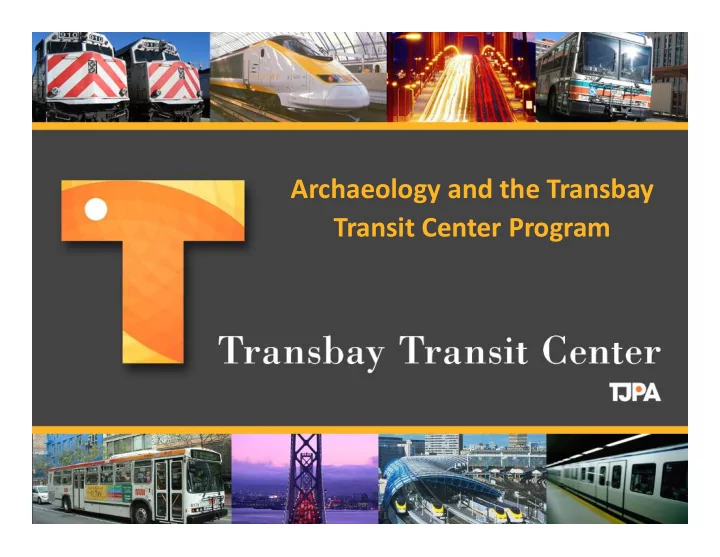

Archaeology and the Transbay Transit Center Program
Determining Where to Test
History of Land Formation • Geotechnical bores provide a picture of how the land surface changed over time. • Sequence helps establish potential for archaeological resources.
Prehistory • Locations of known prehistoric Project Blocks archaeological sites allow archaeologists to create a predictive model for determining where unknown sites are most likely to exist.
Gold Rush Era • The US Coast Survey Map of 1853 depicts the historic shoreline of San Francisco. • The project area is partially located in what was the waters of Yerba Buena Cove.
View from Rincon Hill, 1851 Block 11 within the waters of the cove Fremont Street Block 9 sloping down to the water’s edge
Industrial Expansion Mission The 1887 Sanborn Fire Insurance Map provides detailed footprints of the many industrial enterprises, including foundries, machine works, boiler works, and pump works that were established in the project area. Fremont Beale Howard Source: 1887 Sanborn Map
Living in the Neighborhood 1880 Census • Not far from the industries along the shoreline, small businesses like Tomkinson’s Livery & Stable, a Chinese Laundry, a pork packing factory and a candy factory were interspersed among crowded working-class residences. • Archaeological finds lack significance unless they can be connected to the men and women that created them. Census research allows archaeologists to better understand neighborhoods. Minna Second First Natoma Source: 1887 Sanborn Map
Previous Disturbance After determining the history of land use within a parcel, archaeologists must determine the likelihood that deposits have survived. • Testing is typically not conducted in areas that have been disturbed previously. Examples: • 1906 Earthquake and Fire rubble • Post-quake Rebuilding • Transbay Terminal and Ramp Construction
1906 Earthquake & Fire The earthquake and fire of April 1906 decimated much of the South of Market neighborhood. A layer of earthquake debris is buried throughout much of the area. First Fremont Beale
Post-quake Rebuilding Mission • The residents in the South of Market did not return to their old neighborhoods. • Many lots remained vacant for several years. Second First • City services, like sewers, were often utilized when lots were rebuilt, lessening the likelihood that archaeological features were created in the 20 th century. • Light industry, warehouses, and later parking lots and Howard transportation infrastructure dominated the neighborhood. Source: 1913 Sanborn Map
Terminal Construction • Construction of the original Transbay Terminal would have Excavation for disturbed any archaeological construction of features present in much of the Transbay the building’s footprint . Terminal in 1937 • Construction As-Builts helped guide the drafting of a testing plan by providing specific locations of previous disturbance. Construction As-Built Plan from the Transbay Terminal in 1938
Implementing the Testing Plan
Areas of Testing • Three phases of the project have been tested for archaeological resources in advance of construction: the Temporary Terminal; Shaft and Shoring Wall; and the Demolition, Utility Relocation, and new Transit Center Foundation Excavation (DURF). Archaeological Test Locations Key Project Footprint • Upcoming phases for Temporary Terminal testing include the Bus Storage Facility and Bus Shaft and Shoring Wall Ramps (not depicted on DURF map)
Methods of Testing • Trenching and areal excavation are used to locate historic deposits. • Coring is utilized when testing for deeply buried prehistoric deposits. • Archaeologists are present to identify cultural material discovered during these activities.
Data Recovery • Significant archaeological features found during the testing phase are carefully excavated by hand, then photographed and drawn to scale. • With the aid of historic maps and modern GIS technology, it is often possible to link these features to specific households and businesses.
What We’ve Found
Archaeological Features Privy in plan view as it’s being Privy in profile excavated, south before it is side of Natoma excavated by Street archaeologists, north side of Natoma Street Remains of a wood barrel after the Remains of contents have small, mid 19 th been century excavated, structure, north side of north side of Natoma Street Natoma Street
The Chinese Laundry bone comb ginger jar soy sauce jar rice/soup bowl opium pipe bowl rice wine jar
Personal Items Schenk’s Pulmonic Syrup perfume B.B. Thayer, SF chamber pot charcoal toothpaste comb bone toothbrush
pipe doll marbles Home Life figurine woman’s belt buckle dog collar
At Work casting pattern chisel crucible pulley wheel crucible
Public Outreach • The recently installed exhibition at 201 Mission Street uses artifacts and historic documents to recall the lives of the people who lived and worked in the project area. • This exhibit gives the public a rare glimpse into the history of the neighborhood.
Recommend
More recommend